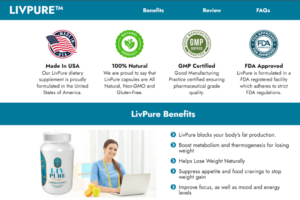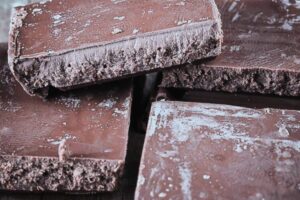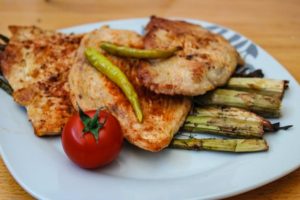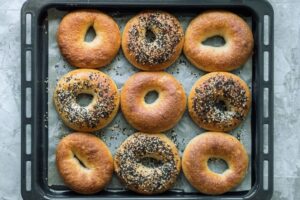Is stainless steel oven-safe? Stainless steel is not breakable, so it’s a better alternative to fragile glassware to use in the kitchen. But how does it hold up in a hot oven? In this article, I’ll describe whether stainless steel is oven-safe or not, as well as details about stainless steel.
Is stainless steel safe in the oven? Stainless steel is oven-safe, provided it is of high-quality steel that does not react with food at high heat. High-quality, heat-resistant steel will not warp and won’t leach nickel into the food.
Avoid using poor-quality stainless steel because manufacturers use cheap alloy combinations, leaching heavy metals into your food. They could also split or bend in extreme temperatures.
Read on to learn more about stainless steel cookware and how you can safely use it in your oven.
Is Stainless Steel Oven-Safe?
Stainless steel is made from a heavy metal alloy containing chromium, silicon, nickel, and manganese, with carbon and nitrogen elements. Manufacturers produce various types of stainless steel by altering the amounts of these components.
Can stainless steel go in the oven? Yes, it is generally safe to use stainless steel cookware in your oven. Just make sure that you have selected the best grade stainless steel to use. Also, use suitable oven temperatures to prevent mishaps. Your stainless steel won’t break, but it may split and bend.
What Are the Requirements for Food Grade Stainless Steel?
Quality stainless steel cookware contains the correct amount of elements to prevent them from leaching into your food. The approximate amount of chromium in quality stainless steel is 11 to 18%. When the chromium content is higher, most likely, the steel is more resistant to corrosion.
The best quality grade stainless steel cookware is the (AISI) 300 series, such as type 304. This type is 18/8 and 18/10. It is composed of 18% chromium and 8%/10% nickel. The second of austenitic stainless steel is type 316. These percentage amounts will prevent rust formation and are nonmagnetic. They also have resistance to heat and corrosion.
The 400 series doesn’t contain nickel, so these types of cookware are more prone to rust formation and are more inferior in quality but less expensive. They are best as kitchen utensils. The 200 series contains manganese instead of nickel, so it is safer but is more affected by heat and prone to corrosion.
The NSF International standard for food equipment material has required that stainless steel, which comes in contact with food, should have a minimum of 15% chromium content by weight.
Although nickel in large amounts can be toxic to the body, it is a crucial component of stainless steel for food cookware. It helps prevent corrosion and oxidation when steel comes in contact with food, especially acidic foods. It should be certified as food-grade stainless steel to ascertain that your stainless steel cookware is safe.
What Makes Bad or Poorly Constructed Stainless Steel?
The poorest quality steel does not contain the right amount of metals and components in the resulting alloy. For stainless steel to be of high quality and oven-proof, the elements must be as stated above.
If the steel’s properties don’t comply with the requirements mentioned above, it is poorly constructed, and you should not use it. You may find yourself being hurt or burnt due to your steel product.
How Is Stainless Steel Made into Cookware?
For stainless steel cookware, the proper amounts of nickel, silicon, chromium, ore, molybdenum, and iron are melted together. This process will produce a sturdy alloy that manufacturers turn into various materials, such as cookware, sheets, medical instruments, appliances, and other useful equipment.
For cookware, the steel must be rust- and heat-resistant and sturdy enough not to split or bend when subjected to heat. Most stainless cookware has an aluminum layer for a polished and non-sticky property. Aluminum would also seal off the components to avoid leaching when coming in contact with food.
How Would You Know If a Stainless Steel Is Safe or Not?

If you want to know whether your stainless steel is safe, you can use the simple ‘magnet test.’ You can do this by placing a magnet close to the stainless steel. If the magnet sticks to the stainless steel, it is safe. It indicates that the cookware contains no nickel that could contaminate your food.
On the other hand, if it doesn’t stick, it means it contains nickel that could react with heat and your food. But note that just the right amount of nickel in your stainless steel cookware is not harmful to your health. Instead, it would increase its austenitic structure, providing durability, flexibility, strength, and rust-resistant property.
Sometimes, they use molybdenum in place of nickel. Molybdenum increases the steel resistance against corrosion and high temperature without the adverse side effects of nickel.
What Makes Quality Stainless Steel for Cookware?
For good quality stainless steel, the requirement is for the elements to be in the right proportions. Nickel must only be enough to render the cookware resistant to rust and heat. This amount is around 8-10% nickel. More than that, it may cause leaching of nickel into your food.
There must also be the right amount of chromium to make the material sturdy and long-lasting, the same as the other heavy metals used to make the alloy.
How Hot Can an Oven Be for Stainless Steel?
Oven temperatures are typically between 325 to 350 degrees Fahrenheit. For roasting or baking, the temperatures can range from 375 to 400 degrees Fahrenheit. You can safely heat your oven at these temperatures and up to 500 degrees Fahrenheit.
But don’t go over 500 degrees Fahrenheit. This temperature is too hot for your stainless steel cookware. You may want to use another cookware if you need to cook at this extremely high temperature. This measure is to avoid mishaps from happening.
Extremely high temperatures would destroy any type of material, even steel. So, don’t be overconfident with your steel cookware.
Advantages of Stainless Steel
With the correct grade or percentages of the alloy elements, stainless steel cookware has several advantages:
- It is easy to use. You can conveniently store, use, and maintain it without encountering significant problems.
- Suitable for cooking as it cooks food evenly and maintains the heat at a constant temperature.
- It’s easy to clean and maintain. You can quickly wash it with hot water and soap and then scrub off the oil easily.
- It’s durable as it doesn’t break easily and can withstand wear and tear effectively. Its life expectancy is more than 50 years. Most probably, you could use it for a lifetime.
- If taken care of properly, it appears modern, smooth, and classy with an aesthetic appeal.
- It is resistant to water and rust. Not many ovens have that property.
- High-grade stainless steel is resistant to corrosion caused by alkaline and acidic solutions.
- It can resist chloride-containing materials even at high pressure and elevated temperatures. Often, food contains salt that could react to your cookware.
- It has excellent tensile strength. This property ensures that you can subject the stainless steel to pressure without rapidly bending or breaking.
- It is environmentally friendly. There are no harmful material components. Although they are heavy metals, their concentrations are not harmful to the environment.
- It is low maintenance. You don’t need expensive solutions or materials to keep the cookware in good working condition.
Disadvantages of Stainless Steel
- High-quality stainless steel is more expensive than other cookware.
- Poor grade stainless steel may smudge and show fingerprints. You have to know how to choose high-grade stainless steel that doesn’t show smudges.
- It may leach toxic heavy metals into your food. This fact is applicable when stainless steel is of poor quality. Grade 304 is ideal for cooking, and grade 400 is excellent as utensils.
- Poor quality stainless steel cookware can contain more nickel that can cause allergic dermatitis and possible accumulation of the heavy metal in your body. This possibility is harmful to your health.
- Inferior quality steel is not durable and is not resistant to heat and rust. It can swiftly accumulate dust and most likely corrode at the slightest pressure or elevated temperature.
We’ve answered the question, “Is stainless steel oven-safe?”; next, let’s look at the factors determining the safety of stainless steel.
Factors Determining the Safety of Stainless Steel

1. The Amount of Nickel Present
If the nickel content is more than what is required by the NFS, the problem of metal leaching into your food will increase. The percentage of nickel must be 8-10% only. More than that can cause problems. As previously mentioned, it can cause health problems, such as allergies.
2. The Amount of Chromium
The inaccurate amount of chromium could also cause problems as this will render the stainless steel less durable. The percentage of chromium must be at least 19%. Steel with more chromium is doubly resistant to corrosion than steel with no chromium content.
3. Extreme Temperatures
Temperatures above 500 degrees Fahrenheit could bend or damage the steel. At this temperature, the stainless steel cookware is unsafe to use. For safer use, maintain the temperature below 400 degrees Fahrenheit.
4. The Quality Grade
For cookware, 304 is the best grade for safe use. You can use the quality grade 400 series safely as kitchen utensils.
5. The Proper Proportion of the Elements in the Alloy
The elements in the alloy must have the proper amount so they can be mixed to produce enough ductility, toughness, and durability.
Tips for Taking Care of Stainless Steel Cookware
You have to know how to maintain your cookware so that it doesn’t corrode or wear down fast.
- Before and after use, clean your stainless steel cookware with soap and hot water. Rinse and dry thoroughly.
- Avoid using hard or abrasive cleaners like bleach and scouring pads when cleaning your stainless steel cookware.
- Buff your stainless steel cookware with stainless aluminum cleaners regularly to maintain their luster and non-stickiness.
- Don’t overheat your stainless steel materials. High-quality cookware is safe to heat up to 500 degrees Fahrenheit but not more than that.
- You can prevent sticking by adding margarine, butter, or non-stick cooking spray to the cold cookware. Heat for two minutes using medium temperature. Afterward, you can then use it without any problems.
- Never use sharp or pointed objects in your stainless steel cookware. These objects can scratch or damage your cookware.
- Avoid using cold water while the stainless steel is still hot, as the sudden combination of hot and cold can cause adverse reactions that could lead to explosions or damage.
- Allow the stainless steel cookware to cool down before cleaning. The sudden contact of the molten material with cold water can cause extreme stress that could damage it.
- Don’t place containers with cold water on top of the stainless steel. This action is the same as putting the water directly on the steel while it is still hot. It will have the same harmful effects.
- Regularly clean your cookware even when not in use. Storing it for prolonged periods without cleaning can allow molds and mildew to grow. This process can happen when you leave food remnants on the steel’s surface. This occurrence is rare, but it’s better to be cautious than sorry.
Conclusion – Is Stainless Steel Oven-Safe?
So to recap and answer the question: “Is stainless steel oven safe?” The answer is yes, it is safe. However, you have to ensure that the steel is of high quality. This measure would guarantee that the steel does not react with food and is heat-resistant.
When stainless steel leaches nickel into your food, it can accumulate in your body. And in large amounts, it may be harmful to your health.
Follow all the precautions recommended above, and you will enjoy using your stainless steel cookware in your kitchen.
Read next:







